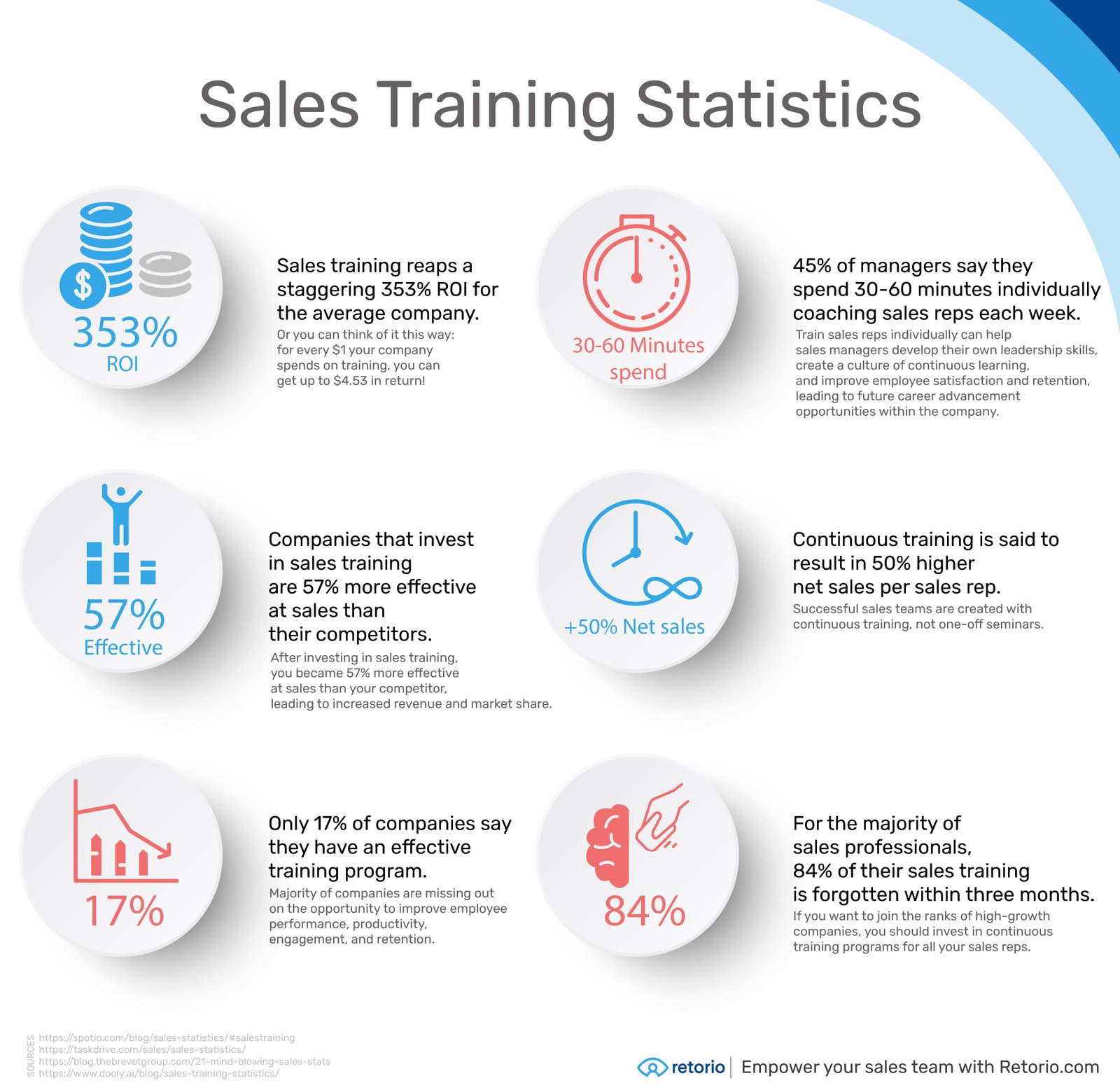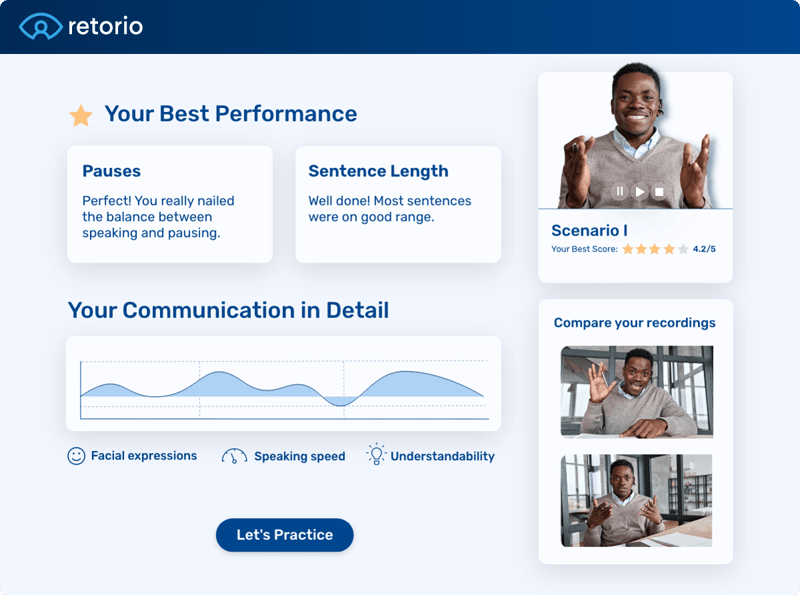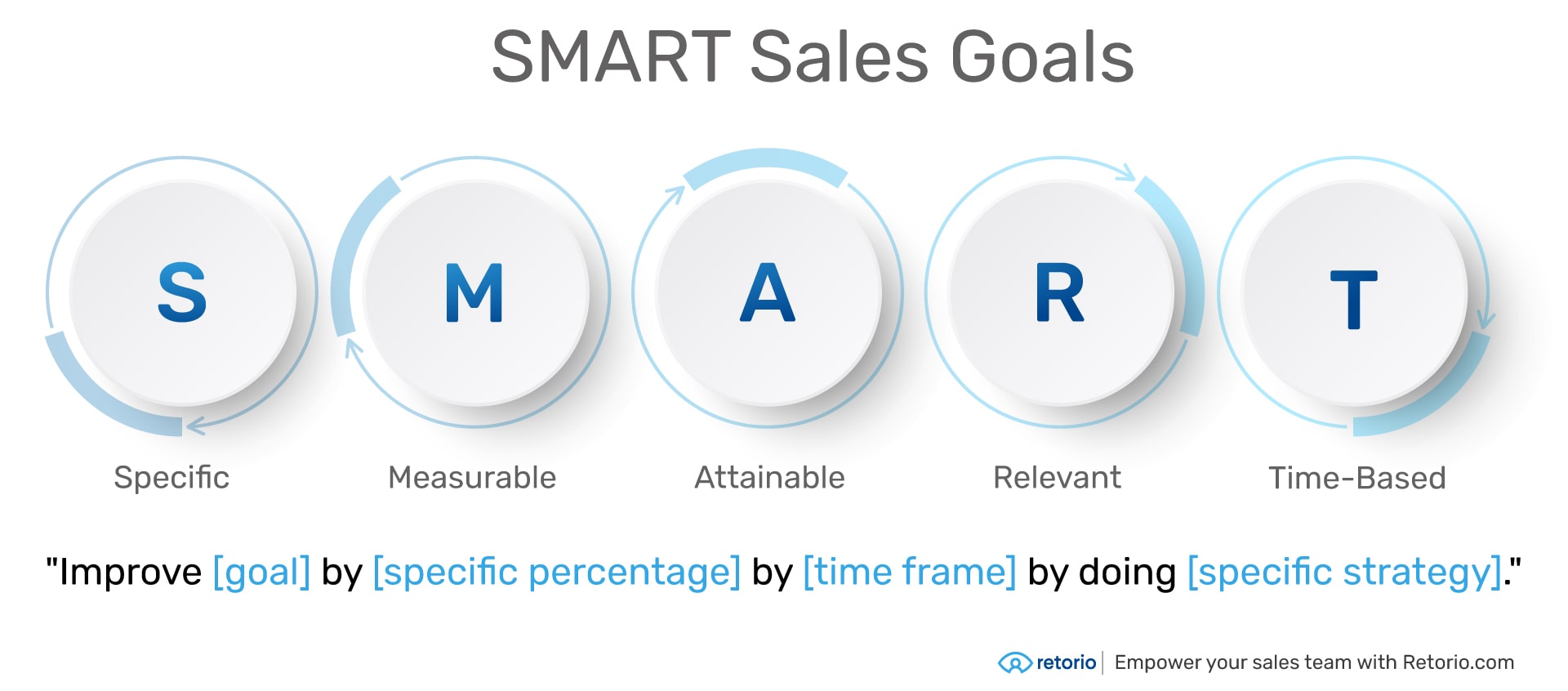
What is sales training? Ultimate guide for professionals
Enhancing sales performance and driving sales growth
50% higher net sales per sales rep with continuous training.a
If you're looking for sales training to boost the productivity and profitability of your sales reps, your customer support, or service teams, you are in the right place.
Before you start investing in sales training programs, it's important to understand what sales training is and how to create an effective learning strategy within your budget.

In this comprehensive sales training guide for L&D professionals, we'll explore the ins and outs of sales training, including key performance indicators (KPIs) to measure the impact of training programs and how to lead standardized global training.
By following the strategies outlined in this guide, you'll be able to develop a top-notch sales training program that drives measurable results and helps your teams reach their full potential.
If you're an L&D professional in a large company and you're feeling overwhelmed with all the new technologies and processes that you have to learn and manage - from e-learning platforms to training budgets, KPIs, and global standardization, then I have the solutions for you that will make you happy.
So how do you create effective learning strategies to train a sales team? It’s important to ensure that training is aligned with the company's goals for success.
Sales training covers a wide range of topics, including customer service, relationship building, cold-calling techniques, communication skills, negotiation strategies, and product knowledge.
Many organizations struggle to train their sales teams because they don’t know how to effectively equip them with the knowledge and skills they need.
Without a clear understanding of customer needs, communication techniques, and product knowledge, sales teams are unable to perform at their best. This can lead to a lack of productivity and lower revenues for the company.
We'll also discuss challenges such as scalability on a budget, soft skills training for hybrid environments, immersive training, and achieving trainee engagement.
So, let's start! 👇
What does sales training mean?
Sales training is the process of equipping your sales team with the knowledge and skills required to increase their performance, productivity, customer service, and customer relations. It covers various topics such as communication techniques, cold-calling strategies, relationship-building, negotiation tactics, and product knowledge.
Sales training is a critical element of any successful sales strategy. According to research from the Corporate Executive Board, businesses that invest in improving their sales capabilities generally experience an 8-14% increase in revenue.
Furthermore, 77% of customers make buying decisions based on the quality of the customer service they receive. So you also need to focus on giving sales training to your customer service teams
It includes understanding customer needs, setting realistic goals, creating a timeline for achieving those goals, providing product knowledge, and ensuring that training is aligned with company objectives.
💡 Related article: How does AI Transform Sales Training? Here you can check out Retorio's immersive real-world sales experience-role-plays, and have your salespeople practice today what they will face on the job tomorrow.
What are sales training characteristics?
The purpose of sales training is to enhance the abilities of sales teams and boost their effectiveness.
It should cover everything necessary and be customized to meet the team's requirements. The focus should be on interactive and engaging training that includes activities relevant to the team's objectives.
Additionally, it should concentrate on improving soft skills like communication, problem-solving, and negotiation.
Sales training characteristics refer to the qualities an effective sales trainer or sales training company or program should possess.
Here are some common characteristics that a good sales training program or trainer should have, according to the provided search results:
- Real-world sales experience: A good sales trainer should have real-world sales experience to gain insights and credibility with the trainees. Sales professionals can quickly recognize if an instructor has not sold before.
 You can check here Retorio's immersive real-world sales experience-role-plays, have your sales people practice today what they face on the job tomorrow.
You can check here Retorio's immersive real-world sales experience-role-plays, have your sales people practice today what they face on the job tomorrow.
- Effective communication skills: An effective sales trainer must be a master communicator to keep the trainees engaged throughout the program. The training should hold the participants' attention, cover a fair amount of information in a relatively short time, and be authentic and genuine.
- Specific skill development: Sales training should be a process of providing the sales force with specific skills to perform better and correct deficiencies in their sales performance.
- Effective time management: A good sales training program should teach salespeople how to manage their time effectively to make the most of every minute of the day so they can spend more time on actual sales. Some of the time management skills that can be taught include prioritizing tasks and planning the day.
- Accessible and bite-sized content: The sales training program should provide bite-sized content that is accessible on a mobile device, making it easier for sales personnel to absorb the training content in the field or on the go. Short-form content keeps trainees more engaged and encourages them to keep learning.
- Collaboration: A good sales training platform should be collaborative, allowing various departments within an organization to work together and share best practices to create deep and relevant experiences.
- Mentorship: Providing mentor relationships between managers and experienced reps is one of the most effective ways to level up the team's sales skills.
- Learner-focused: Great sales trainers should be learner-focused and use sound sales training methodology and strong facilitation skills to draw out best practices and transfer knowledge.
- Individualized approach: The trainer should adjust the training programs to the individual abilities and aptitudes of the trainees. Individual teaching machines and adjustments of differences should be provided.
- Self-direction: A good sales training program should provide ample learning opportunities that exist outside of the traditional classroom setting and nurture self-direction by allowing sellers some level of autonomy throughout the process.
Why sales training is important?
Sales training is an essential part of any business, regardless of size or industry.
It helps create alignment and consistency in the sales process, drives revenue growth, prepares salespeople for customer interactions, gives businesses a competitive advantage, develops important skills such as cold lead prospecting and building relationships with clients, enhances company reputation, and provides product knowledge to reps so they can become more comfortable making presentations and closing deals.
Investing in ongoing sales training programs will help ensure that your team has all the tools necessary to be successful now and in the future.
- Alignment: Sales training helps create consistency in the sales process and ensures that all team members are following the same procedures, techniques, and strategies. This reduces discrepancies within the business and creates a unified approach to selling.
- Revenue: With comprehensive training, sales teams can close more deals and ultimately generate more revenue for the business.
- Preparedness: Providing product knowledge, pricing information, and presentation skills to salespeople allows them to better prepare for their interactions with prospects and customers. This can make a huge difference when it comes to closing deals.
- Competitive Advantage: Ongoing training gives sales teams the edge they need to build relationships that lead to customer retention and recurring revenues.
- Skills Development: Sales training programs help develop important skills such as how to approach cold leads, create new opportunities, close deals, and build rapport with clients. This helps keep employees up to date on the latest industry changes so they can be more effective in their roles.
- Company Reputation: Salespeople are a direct reflection of the company, and ongoing training helps ensure that they are always presenting themselves in the best possible light.
- Product Knowledge: With the right product knowledge and understanding, sales reps can become more comfortable making presentations and closing deals. This can help reduce weak links within the organization that rely heavily on others to complete basic tasks.
What is the role of sales training in Enterprise Companies?
Sales training in enterprise companies is a key component of any successful business strategy.
Sales training can lead to increased revenue for multinational
companies. Enterprise companies that invest in sales training see an
average revenue growth of 24% 1
It helps them align their sales process, build rapport with customers, and acquire new skills that can help close more deals.
Enterprise companies have a lot of complex challenges to face when it comes to sales training, such as scalability on a budget, soft skills training for hybrid environments, immersive training, and achieving trainee engagement.
 Retorio is probably the best choice for enterprise companies with fully scalable and easy-to-use features. With personalized learning paths, gives immediate in-depth feedback on facial expressions, gestures, voice, language! You can discover more
Retorio is probably the best choice for enterprise companies with fully scalable and easy-to-use features. With personalized learning paths, gives immediate in-depth feedback on facial expressions, gestures, voice, language! You can discover more
For an effective enterprise-level sales training strategy it's important to focus on learning and development professionals who are knowledgeable about the organization’s products and services. The organization should also create clear objectives for each program before launching them so everyone understands what they need to accomplish during the course or workshop.
From there, organizations should develop key performance indicators (KPIs) to measure the impact of training programs and track progress over time.
Organizations should also invest in comprehensive global training solutions that are easy to use, customizable, and effective.
| Good companies | Great companies |
|
Offer training in multiple types of skills |
Create specific learning journeys to build the distinct skills needed in each role |
|
Get the support of their organization's sales leaders |
Ensure sales leaders own and drive the program |
|
Use high-quality off-the-shelf content |
Tailor content to their sales force's specific selling motion |
|
View training as a once-a-year exercise |
Invest in continual on-the-job skill building |
|
Measure results based on training completion |
Measure results based on sales impact (pipeline, revenue, and margin growth) |
Source: McKinsey
This will ensure that everyone is receiving the same quality of instruction regardless of location or language. Lastly, it’s important to provide autonomy for salespeople so they can be creative with their approach and work within their unique style.
What is the goal of sales training?
Sales professionals should undergo sales training to improve their skills, keep up their motivation and update their knowledge. When designed well, sales training programs can help them enhance their communication skills, gain insight into their buyer's behavior, adopt proven selling methods, and understand their company better. The essential things that salespeople should take away from sales training include effective communication, buyer understanding, proven selling tactics, and organizational knowledge.
- Develop effective communication skills: To improve your communication skills, you can take a sales training course that covers techniques like asking open-ended questions, framing views, being open, observing, conveying messages, giving feedback, and choosing the right words.
- Understand the buyer: To engage in buyer-responsive selling, a salesperson must understand the buyer's needs and preferences. Providing the buyer with what they want, when they want it, can go a long way in building trust and closing deals.
- Pick a proven selling approach: It is advised to consistently use a single selling approach instead of mixing ideas from different places. Therefore, selecting a reliable selling technique and adhering to it entirely is crucial.
- Learn about the organization: Including an introduction to the organization's culture, mission, and vision statement in the sales training can assist the salesperson in aligning their approach with the organization's values and goals.
- Improve both hard and soft skills: In order to be successful in their profession, a salesperson is required to have expertise in both technical and interpersonal skills. They need to grasp the technical aspects of their role while also enhancing their emotional intelligence or people skills. This is crucial for achieving their objectives.
- Practice sales techniques: According to research, it is recommended that sales training programs provide chances for salespeople to practice their skills and receive feedback from veteran trainers. This approach can enhance their abilities and self-assurance.
- Address poor performance: Managers in sales need to address any issues related to poor performance without delay. It is also important that they know how to create and oversee a performance improvement plan (PIP).
To put it briefly, sales training must equip salespeople with the essential abilities to effectively communicate, comprehend the customer, use proven sales techniques, learn about their company, enhance both soft and hard skills, and tackle underperformance.
By becoming proficient in these areas, salespeople can develop stronger bonds with their clients, seal more deals, and achieve greater success in their careers.
What is a S.M.A.R.T. goal for sales training?
A smart goal for training is Specific, Measurable, Achievable, Relevant, and Time-bound.
To make sales training effective, set a SMART goal that must be specific, measurable, achievable, relevant, and time-bound. The goal must clearly define what the training aims to accomplish, such as upskilling the sales team, enhancing revenue, or improving customer satisfaction.

To guarantee success, goals must be measurable, achievable within the given time frame, and aligned with the company's overall goals. This motivates the sales team and allows progress to be tracked and evaluated, so adjustments can be made as needed.
It is important for the goal to align with the needs of the sales team and the company's sales strategy to ensure that the training provided is useful for the sales team in achieving desired results.
To ensure success, make sure your sales training goals are specific, measurable, attainable, relevant and time-bound. This will create urgency and keep the sales team focused on achieving their objectives within a given timeframe. Having a well-defined and achievable goal will drive company success and the success of the sales team.
For example, a company might set a goal to have 95% of salespeople complete an online sales certification program within 12 months. From there they should develop specific strategies to help employees reach this goal such as offering incentives for timely completion or creating multiple pathways for learners who might need additional support.
- Specific: A specific goal is one that clearly outlines what an individual or organization is aiming to achieve. Examples of specific goals include “increase sales by 10% within 12 months” and “complete an online certification program within 8 weeks.”
- Measurable: Measurable goals have clear metrics attached to them so progress can be tracked. This could include a number of sales closed, customer satisfaction ratings, or completion rate for a training program.
- Achievable: Achievable goals are those that are realistic and attainable given the resources, timeline, and budget available. Goals should push people to reach new heights but also give them enough room to be successful. For example, if a company has limited resources it might not make sense to set a goal of increasing sales by 50% in one year.
- Relevant: Relevant goals align with the organization's overall mission and objectives. It's important to look at how the goal will impact the company as a whole rather than just focusing on the individual or departmental level. An example of a relevant goal could be having 80% of sales representatives pass their certification exams within 6 months to ensure they have up-to-date knowledge about products and services as well as customer service best practices.
- Time-bound: Time-bound goals specify when the goal should be achieved by setting a deadline for completion. This helps keep everyone on track toward achieving their objectives while also allowing for adjustments if something unexpected happens along the way. An example of a time-bound goal could be having 100% of employees complete an onboarding course within 4 weeks after starting their positions to ensure they understand all policies and procedures before engaging with clients or customers directly.
I would like to give you some examples so that you can separate the SMART sales goals (selling purpose) from the SMART sales training (training outcome) goals.
Here are some examples of SMART sales training goals:
-
Increase the number of qualified leads generated by sales representatives by 30% in the next quarter through targeted prospecting and lead nurturing training.
-
Improve the average conversion rate of sales representatives from leads to closed deals by 20% in the next six months through training on effective sales techniques, objection handling, and negotiation skills.
-
Enhance the product knowledge of sales representatives by 50% in the next quarter through comprehensive product training and certification programs.
-
Increase the average deal size by 15% in the next six months through training on upselling and cross-selling techniques, effective pricing strategies, and negotiation skills.
-
Reduce the sales cycle time by 20% in the next quarter through training on effective sales process management, time management, and sales automation tools.
Here are some examples of SMART sales goals:
- Increase sales revenue by 20% in the next quarter.
- Improve win rates by 15% in the next six months.
- Increase the average deal size by 10% in the next year.
- Reduce customer churn rate by 25% in the next six months.
- Increase the number of new customer acquisitions by 30% in the next quarter.
- Improve the response rate of sales emails by 20% in the next three months.
- Increase the number of outbound calls made by the sales team by 25% in the next quarter.
- Reduce the time to close a deal by 20% in the next six months.
- Improve customer satisfaction scores by 15% in the next year.
- Increase cross-selling and upselling rates by 10% in the next quarter.
What are the types of sales training?
Sales Training can be divided into several distinct types, including Vendor Differentiation Training, General Sales Skills Training, Soft Skills Training and Sales Management Training.
There are several types of sales training, which include:
Vendor Differentiation: This type of training focuses on why customers should buy from your company instead of someone else. The course content will vary, but it should offer tactics and techniques for positioning your firm as the best option in the market.
 How can you sell your products and services without differentiation? Sales training is very important at this point. Nobody wants to receive an ordinary service.
How can you sell your products and services without differentiation? Sales training is very important at this point. Nobody wants to receive an ordinary service.
You need to train your sales team to create an exceptional experience.
Vendor Differentiation Training covers a variety of topics related to how companies can differentiate themselves from the competition. It focuses on identifying customer needs and providing tailored solutions based on these needs in order to stand out among others in the market. The course content includes tactics such as understanding the customer’s journey, creating value propositions, and considering the customer's budget. Additionally, it also offers advice on how to create effective marketing campaigns and identify opportunities for innovation in order to stay ahead of the competition.
General Sales Skills training is geared towards equipping sales professionals with the skills they need to succeed in their roles.
This type of training covers a range of topics such as relationship building, questioning methodologies, proposing solutions, negotiation techniques and problem-solving tactics.
It also teaches sales representatives how to make high-impact opening statements, use one-liners to prepare the sale (e.g., working from scripts), avoid and overcome silences, make appointments, build rapport with customers and close the sale.
Also, general sales skills training helps professionals understand how to create tailored value propositions for each customer and provide customized solutions that match their needs.
This type of training is essential for any salesperson as it helps them become more efficient in completing tasks, improve customer relationships and ultimately increase revenue for the company. 2
Soft Skills Development is an essential component of sales training and plays an important role in helping sales professionals become more successful. It includes topics such as communication, resilience, flexibility, active listening, empathy, coaching tactics (Check Sales Coaching Examples: The Ultimate Guide for L&D Professionals), analytical thinking, rapport building, Non-Verbal Language (NLP), motivation techniques, collaboration strategies, leadership skills and a focus on achieving results.

Our platform right place to improve your sales team's soft skills. Retorio uses video analysis to capture and analyze the user's facial expressions, body language, tone of voice, and other nonverbal cues, providing feedback on areas for improvement. The AI algorithms then analyze the video, identifying patterns and characteristics in the user's behavior. The platform provides personalized feedback based on these patterns, highlighting areas where the user can improve their soft skills. Check here
Plus, this kind of training helps salespeople understand how to work together effectively as part of a team and build strong relationships with customers.
By investing time and resources into this type of training, companies can ensure their sales reps are well-equipped to handle customer queries and objections efficiently while providing tailored solutions that meet the customer's needs. This will ultimately help the organization reach its goals by increasing revenue and improving customer satisfaction levels.
Inside Sales training focuses on equipping sales professionals with the skills necessary to effectively sell products and services over the phone or via email. It covers topics such as cold calling, lead generation and management, effective sales prospecting and techniques, upselling methods and more.
Also, Inside Sales training provides guidance on how to create an effective customer service approach that is tailored for each customer's needs and wants. Furthermore, it teaches essential negotiation tactics and provides guidance on how to create custom value propositions for each customer. By investing in this type of training, sales representatives can become better equipped to handle a wide range of scenarios, understand their customers better, build strong relationships and successfully close deals while providing tailored solutions that are beneficial to both the company and the customer.
Field Sales training is designed to help sales representatives become more successful in their roles and equip them with the skills they need to close deals. It covers topics such as how to conduct effective sales meetings, create tailored value propositions for each customer, negotiate deals, and successfully close sales.
This type of training also provides guidance on how to create an effective customer service approach that builds strong relationships between customers and the company. Also, it teaches essential negotiation tactics and provides guidance on upselling methods and other strategies that can help drive increased revenue for the organization.
With Field Sales training, sales professionals can develop their skills in areas such as relationship building, questioning methodologies, proposing solutions, creating custom value propositions, and closing the sale. These skills are essential for any salesperson as they will help them become more efficient in completing tasks, improve customer relationships and ultimately increase revenue for their company.
Service Sales training is designed to equip sales professionals with the skills and knowledge necessary to effectively sell services rather than products. It covers topics such as how to communicate the value of the service, manage customer expectations, upsell and cross-sell services, build long-term customer relationships, and create tailored value propositions for each customer.
This type of training provides guidance on how to conduct effective sales meetings, negotiate deals, and successfully close sales.
By investing in Service Sales training, sales representatives can develop their skills in areas such as relationship building, questioning methodologies, proposing solutions, creating custom value propositions and closing the sale.
Studies have shown that investing in service sales training can lead to a significant return on investment (ROI). One study found that companies who invested in sales training saw an average ROI of 582%. Another study showed that companies who invested in service sales training saw an average increase of 8.2% in their gross profit margin.
This will help them become more successful in their roles while providing tailored solutions that are beneficial to both the company and the customer.
Sales Management training is essential for sales managers who want to ensure their teams are successful in achieving their goals. It covers topics such as recruiting, training, and motivating sales teams; setting realistic and achievable sales goals; managing and analyzing sales data; and optimizing the sales process. Also, this type of training provides guidance on how to develop effective strategies that will help improve customer satisfaction, increase customer retention rates, and maximize profits. By learning how to create tailor-made value propositions for customers, build strong relationships with them, upsell and cross-sell services or products effectively, and use negotiation techniques to close deals successfully, sales managers can become better equipped to lead their teams toward success.
Product Knowledge training equips sales representatives with a deep understanding of the products or services they are selling. It covers topics such as product features, benefits and unique selling points, how to address common customer objections, and how to upsell and cross-sell additional products that could be beneficial for the customer. This type of training is essential for making sure sales representatives have an in-depth understanding of their company's offering so that they can effectively communicate their value proposition to customers, build strong relationships with them, and close deals successfully. Also, this type of training also helps sales representatives become better equipped to create tailored solutions for customers based on their needs and preferences.
Real-World Training Exercises are a great way to give sales representatives hands-on experience in the field. This type of training involves incorporating sales content into instructional programs, helping sales teams to practice real-life scenarios and pitches in guided activities. Through this training, participants can gain a better understanding of customer needs and preferences, learn how to identify the best solutions for each customer and develop the skills needed to successfully close deals. Additionally, these exercises enable sales professionals to learn from their mistakes and receive feedback from their peers or trainers on their performance. By dedicating resources to Real-World Training Exercises, organizations can ensure that their sales teams are equipped with the necessary skills and knowledge needed to exceed customer expectations and maximize profits.
By understanding the different types of sales training, L&D professionals can create effective learning strategies for their teams. They can also ensure that the content is relevant and up-to-date so that it meets the changing needs of their organization.
Furthermore, they should consider providing standardized global training programs in order to meet international requirements and increase efficiency across teams. With careful planning and execution, L&D professionals can create successful and impactful sales training programs that will benefit their teams.
Why sales training is important?
Sales training is crucial for enterprises, as it can help to increase revenue, build relationships with customers, and provide a competitive edge in the marketplace. Here are several reasons why sales training is important for enterprises:
Alignment: Sales training creates alignment within the sales team and ensures that all salespeople are following the same sales methodologies, which helps to reduce inconsistencies within the business.
Revenue: Sales training is essential because sales generate revenue, which is the lifeblood of any business. A well-trained sales team will outsell competitors and build relationships for future business. 3
Preparedness: Sales training provides the necessary product knowledge, pricing information, and presentation skills to help salespeople stand in front of potential customers confidently. Being prepared with these skills can make all the difference in the world and increase the chances of closing a sales.
Competitive Advantage: Sales training is one of the most critical competitive advantages a business can have. Ongoing training ensures that the sales team can shine as confident, skilled professionals who can build key customer relationships. This helps to grow awareness for the brand, lead to customer retention, and drive recurring revenues. 4
Skills Development: Most sales training programs help develop sales skills and techniques needed to approach cold leads, create new sales opportunities, close deals, and build rapport with clients and customers. This helps to improve the skills and knowledge of employees to match the various changes in the industry and increase their overall effectiveness as salespeople. 5
Company Reputation: Salespeople are a direct reflection of a company, and their actions can impact the company's reputation. Continued education is critical to the success of the sales team and should be provided as often as possible to ensure they are always presenting themselves and the company in the best possible light.
Product Knowledge: Proper product training can make a big difference when a sales prospect objects. With the right knowledge, sales reps can become more comfortable in making sales presentations and closing deals. Sharing product knowledge across the sales organization is a source of power that can help to reduce weak links within the company that rely heavily on others to complete basic work tasks. 6
Overall, the importance of sales training for enterprises cannot be overstated. It can help to increase revenue, build relationships with customers, provide a competitive edge, improve skills and knowledge, enhance a company's reputation, and ensure that salespeople have the necessary product knowledge to close deals. As such, enterprises should prioritize sales training as part of their overall business strategy.
What training needs for sales team?
The needs of sales teams are often highly specific to the organization. However, there are some universal areas that can be addressed through training. These include:
1. Soft skills: Active listening, stress management, public speaking, persuasion and influence, customer service, building relationships, teamwork, and collaboration
2. Technical skills: Product knowledge, account management, and understanding of customer requirements
3. Professionalism, Including customer service standards and company meeting goals.
4. Understanding the company's values, mission, goals, and objectives
5. Setting performance targets and maintaining motivation levels
6. Preparation for sales presentations and demonstrations;
7. Utilizing digital resources such as social media networks or web portals to show sales excellence and reach potential customers;
8. Time management in order to balance daily tasks and long-term goals;
9. Understanding the sales funnel from initial lead qualification to closing a sale.
Customer feedback is valuable for training sales teams. Cross-training with other teams like customer service can give insights into customer needs and purchase decisions.
Sales training should be tailored to each team's needs, as well as regularly updated with new techniques and best practices.
This ensures that sales teams remain competent, knowledgeable, and motivated in their roles. It also helps them stay competitive in an ever-changing market environment.
How to measure sales training effectiveness?
As an L&D professional, it is essential to measure the effectiveness of sales training to ensure that it is producing the desired outcomes.
There are various ways to measure sales training effectiveness, and it is important to use key performance indicators (KPIs) to make the measurement more data-driven.
Here are some steps that you can take to measure the effectiveness of your sales training program:
Clearly identify training goals: Defining clear goals for training can have multiple benefits, such as providing direction and setting standards for LD programs, and establishing measurable criteria for evaluating training results. For instance, goals could range from streamlining staff onboarding to guaranteeing safe operations.
Use the Kirkpatrick Model: The Kirkpatrick Model is a well-known technique that assesses the effectiveness of training programs using four levels: reaction, learning, behavior, and results. By using this model, a thorough evaluation of the training program can be obtained. 7
Measure tangible results: Measuring the tangible results after training is crucial. These results could include reduced costs, improved quality, faster project completion, increased productivity, employee retention, better marketing leads, increased sales, and higher morale.
To determine the success of the training, metrics such as improved business results, increased productivity and quality of work, employee retention, and higher morale should be used. 8
Use KPIs: Create measurable metrics called KPIs to provide employees with clear goals and a way to track their progress. To measure the effectiveness of sales training, some examples of KPIs are sales revenue, activity levels, hours worked, productivity, sales messaging tactics, techniques, and individual quota attainment.
Measure engagement, behavior change, and knowledge retention: To properly evaluate training effectiveness, it's crucial to measure engagement, behavior change, and knowledge retention. Engagement indicates employees' level of interest and involvement in the training program.
Behavior change correlates with whether employees are utilizing the training they received in their daily work. Knowledge retention comprises how much information employees can recall and understand from training.
To measure the effectiveness of your sales training program in a data-driven way, you can follow these steps: 1) identify training goals, 2) use the Kirkpatrick Model, 3) measure tangible results, 4) use KPIs, and 5) measure engagement, behavior change, and knowledge retention.
This will allow you to pinpoint areas for improvement and adjust the program accordingly to achieve desired outcomes.
What makes a sales training successful?
When it comes to making sales training successful, there are a variety of factors to consider. Based on the search results, here are some key components to keep in mind:
📌Real-world experience: To provide deep and relevant learning experiences, sales trainers should have real sales experience that they can use to provide relevant examples and insights. They should be able to transfer knowledge effectively and create an environment where individuals can learn from each other.
📌Interactive sessions: Training sessions that are live and interactive, with activities and discussions, are more effective than traditional lecture-based presentations. This type of training allows learners to safely practice skills, receive feedback from peers, and reflect on their experiences, making it more engaging and memorable.
📌Essential sales skills: It's recommended that even experienced sales reps undergo training to polish their foundational sales skills like identifying potential clients, crafting cold emails, and making cold calls. It's crucial to evaluate the essential selling skills required for your particular product or team and customize the training accordingly.
📌Continuous learning and reinforcement: Rather than being a one-time event, sales training should be an ongoing process. The process can include reinforcement which aims to improve retention, build confidence, and reinforce learning. This can be achieved through coaching that happens regularly, follow-up sessions, and the offering of easily accessible resources. 9
📌Leadership/management training: To ensure success in major sales due, it's crucial to give salespeople leadership and management training that focuses on your sales organization's objectives, values, and clients. Additional training may be necessary to prepare them properly. 10
📌Understanding the products/services: To sell effectively, it is essential for sales teams to have ample knowledge about the products or services they are selling. Therefore, it's crucial to update the sales team regularly on any new features or updates.
To make sure your sales training is effective, include the following components in results sales training: experienced trainers who provide real-world examples, interactive sessions with practice and feedback, essential sales skills training, continuous learning and reinforcement, leadership and management training, and a good understanding of the products and services sold. Incorporating these components will help ensure the success of your sales training program.
What kind Sales Training Techniques L&D professionals can use?
Improving sales skills and knowledge in sales process, strategies, techniques and technology is known as sales training. This helps sales professionals and managers to better comprehend buyers and update their sales approach, to achieve success in sales. L&D professionals can use various training techniques to enhance sales practices.
- Prioritizing tasks: Sales teams can learn effective time management skills through training from L&D professionals that include task prioritization.
- Planning your day: It is recommended that salespeople organize and plan their day in advance to improve their productivity and stay organized.
- The 80/20 rule: The Pareto principle suggests that 80% of the results come from 20% of the efforts. L&D professionals can use this technique to teach salespeople to focus on the 20% of efforts that generate 80% of the results.
- Setting deadlines: To prioritize tasks and ensure timely completion, it is helpful to establish deadlines. 11
- Tracking time: L&D professionals can teach salespeople how to improve their productivity by tracking their time.
- Pomodoro technique: The technique mentioned is called the "Pomodoro technique", where one works for 25 minutes with focus, followed by a short break. Its implementation can aid salespeople in managing their time wisely and avoiding burnout.
- Project management software: Project management software can benefit sales teams by facilitating collaboration, task management, and organization.
- Batch tasking: Salespeople can improve their focus and save time by grouping similar tasks together.
- Establishing an effective routine: Salespeople can stay organized and productive by developing a consistent routine.
- Field training: Field training can be used by L&D professionals to enhance sales team productivity and acquire new techniques.
- Sales enablement certification: L&D professionals can suggest that salespeople pursue a sales enablement certification in order to improve their expertise and understanding.
- Sales training workshops: Conducting interactive sales training sessions can help sales teams to develop their skills and learn new techniques.
- Sales coaching: Sales teams can improve their skills and find areas for growth by receiving sales coaching and feedback. 12
- Group training methods: Group training is an effective way for L&D professionals to provide sales teams with sales and customer service skills. It can also help build teamwork, communication skills, and trust among team members. Team building activities and competitions can be used to further improve team engagement. Sales role-play, salespeople can develop their skills in a low-pressure environment using role-play activities that simulate real-life situations.
How much does sales training cost?
The cost of sales training programs can vary greatly depending on factors such as the program type, duration, and scope of training. According to different sources, publicly available sales training programs can cost between $400 and $5,000 per participant. 13
However, private training programs can be more expensive, with some programs costing thousands of dollars per participant. 14
It is crucial for enterprises to find a sales training program that meets their budget, team size, focus, and specific needs. The cost of such a sales training program can vary from tens of thousands to hundreds of thousands of dollars, depending on the size of the sales team and the extent of the program.
If a sales team of 100 has a quota of $1 million per person and a typical deal size of $50,000, they could potentially boost their revenue by $20 million if they undergo effective sales training.
Based on another study, companies that exceeded expectations with their sales training programs spent an average of $2,870 per participant. 15
5 Sales Training Examples
1. On-site and Online Training
On-site and online training are two of the most popular methods used by organizations to provide sales teams with learning and development. On-site programs are ideal for allowing participants to benefit from an immersive learning environment, personalized feedback, and close collaboration with trainers. On the other hand, online programs offer more flexibility and cost savings.
Project management software can be beneficial for sales teams by helping them to manage tasks and collaborate effectively. Batch tasking is another effective tactic that allows salespeople to group similar tasks together and save time on completing them. Establishing a consistent routine also helps salespeople to stay organized and productive.
2. E-learning
E-learning is a great way for companies to provide sales teams with learning and development opportunities without the need for travel or an instructor present. It can be used to reach large numbers of people in an easy and cost-effective manner while providing learners with engaging, interactive experiences. With e-learning, learners have the flexibility of learning at their own pace, which allows them to focus on topics that are most relevant and interesting to them. Additionally, companies can create assessments and track individual learners' progress with e-learning platforms.
3. Immersive Learning Experiences
Immersive learning experiences can be an effective way to help sales teams improve their product knowledge, skills, and selling techniques. These learning experiences are tailored to meet the needs of specific teams and can take the form of classroom simulations, virtual reality scenarios, or experiential activities. Immersive learning allows learners to practice in a safe, realistic environment and receive feedback from instructors in real-time. Additionally, these experiences can be used to teach soft skills such as communication, negotiations and decision-making. By providing learners with the opportunity to practice their skills in a risk-free setting, they will be better prepared for real-world sales scenarios.
4. Soft Skills Training
Soft skills are essential for sales teams to effectively communicate and persuade customers. Companies can invest in training programs that focus on developing these skills, such as communication, persuasion, negotiation, networking, and customer service. Soft skill training can be tailored to the specific needs of a team while providing them with the knowledge they need to succeed. Additionally, companies can track the progress of their sales team to measure the impact of training initiatives and make sure they are making improvements over time. By investing in soft skills training, companies can ensure that their sales teams are well-prepared to interact with customers and increase their success rate.
5. Gamification
Gamification is a powerful tool to help engage sales teams and motivate them to learn. Through gamification, companies can create a competitive environment that encourages learners to progress through courses and track their progress with leaderboards, badges, or point systems.
By providing rewards for completing tasks or reaching certain levels in the course, learners will be motivated to stay engaged and continue learning. Additionally, this type of system allows companies to track individual learners' progress and measure the impact of training initiatives. Gamification also makes topics covered in training more interesting and enjoyable for learners—encouraging them to learn new skills and master existing ones. 16
Creating a Comprehensive Sales Training Program for Pharma, Automotive, and Retail Sectors step-by-step
As an L&D manager, your role is to equip your team with skills and knowledge that will help them efficiently handle sales. Here's a comprehensive sales training program designed to improve your team's skills, including a step-by-step approach and sector-specific modules.
Step 1: Understanding the Basic Sales Process
The first module will help your team understand the basic sales process, which includes the following:
- Identifying potential customers: First, you need to know your target market or audience. Who are the customers you are selling to?
- Nurturing and Qualification: After finding your potential customers, you need to assess their interests and qualification. In this module, your team will learn how to nurture leads and progress them through the sales funnel.
- Closing the sale: This module focuses on closing the deal by explaining how your team can effectively identify, address, and overcome the concerns of prospective customers
Step 2: Sector-Specific Training
After the team has learned how to understand the basic sales process, the training program will move on to sector-specific training modules. This is where the program will refine the skills your team needs and key strategies to follow based on the sector of operation.
Pharma Sales Training
The following modules will be specific to pharma sales:
-
Legal and compliance in pharma industry sales: Your team will learn how to work in compliance with legal healthcare regulations, what restrictions and requirements apply to them, and how to avoid ethical violations.
-
Understanding medical terminology: In pharma sales, it's vital to understand the technical terms involved in healthcare. Thus, your team will learn to understand the common terms within the medical context and how to use them while communicating with potential customers.
-
Tailoring solutions to clients: In the pharma sector, each potential customer has unique needs. Your team will learn how to identify the client's needs and tailor their solutions to meet those needs.
💡 Related article: What are the Best Sales Training Programs for Medical Sales Reps
Automotive Sales Training
The following modules will be specific to automotive sales:
-
Understanding vehicle specifications: In automotive sales, knowledge of vehicle specifications is vital. Your team will learn the crucial technical details of what makes a car desirable while paying attention to their preferences or usage needs.
-
Specifications demonstration: In automotive sales, product demos are critical to closing a deal. Your team will learn how to give demonstrable, compelling presentations to close more sales.
 Retorio has complimentary training content for your sales reps and also works with partners to create customized training for your needs
Retorio has complimentary training content for your sales reps and also works with partners to create customized training for your needs
-
Vehicle financing options: Most car purchases are financed, so your team will learn financing options that potential customers might consider purchasing.
💡 Related article: The Ultimate Guide for Scalable Automotive Sales Training
 German Premium OEM builds a more customer-centric sales team with Retorio immersive video simulations. You can check the case study here
German Premium OEM builds a more customer-centric sales team with Retorio immersive video simulations. You can check the case study here
Retail Sales Training
The following modules will be specific to retail sales:
- Negotiation skills: Since retail sales are based on acquiring product sales, negotiations are essential. In this module, your team will learn negotiating skills to close deals faster and compensate customers for a satisfied purchase.
- Product knowledge: Your team will learn about various products and their features and how to use those details to influence customer decisions.
- Handling objections: In retail sales, customers usually have objections while making a purchase, and knowing how to handle them is essential to pick up the sale.
Step 3: Developing Scenarios
Scenarios will provide the team with a chance to apply newly learned skills and knowledge in practice. Develop different scripts or scenarios for participants to show how to tackle various sales challenges effectively.
Step 4: Incorporating Role Plays
Role-play activities will allow your team to practice under real-world conditions. Conduct scenarios to assess your team's performance and provide feedback on how they can improve further.
Step 5: Testing Participants
Finally, to evaluate the effectiveness of the program, conduct a test at the end of each training module or divide the entire program into workable terms and assess the team's performance. This will provide credibility to the training program and help identify areas that need further improvement.
Sales Training KPIs
Sales performance KPIs are key metrics that can be used to measure the impact of sales training programs. Companies should consider using metrics such as customer satisfaction levels, revenue growth, and team collaboration. Additionally, tracking metrics such as the number of deals closed per month, average order size, and customer retention rates can provide valuable insights into how successful the training program has been.
-
Cost Per Learner: This metric will help you understand how much you are investing in each learner, which can inform decisions about budgeting and resource allocation.
-
Methodology (and Technology) Adoption: Tracking how quickly learners are adopting new methodologies or technologies can help you identify areas where additional training may be needed.
-
Time to Proficiency: Measuring how long it takes for learners to reach proficiency can give you an indication of how effective your training program is at teaching new skills.
-
Sales Goals: Tracking sales goals will help you determine whether or not your training program is helping your team meet their targets. Here are some examples of sales goals:
⚪ Sales conversion rates: This will give you an idea of how effective your sales team is at converting leads into customers.
⚪ Average deal size: This will help you understand how much money each customer is spending on average.
⚪ Time taken to close deals: This will help you identify any bottlenecks in the sales process that are preventing deals from being closed quickly.
⚪ Number of demos conducted: This will help you understand how many potential customers your sales team has interacted with.
⚪ Customer satisfaction ratings: This will provide insights into how satisfied customers are with their experience with your product and service.
-
Participation levels in the training: This will help you understand how engaged employees are in the training program.
-
Employee retention rates: This KPI will provide insights into whether or not employees are staying with your company after they have completed the training program.
-
Employee Engagement: Monitoring employee engagement levels can give you insight into how motivated and engaged learners are with the material being presented in the training program.
How AI and Behavioral Intelligence can help your Sales Training?
Retorio's AI and Behavioral Intelligence platform offer multifaceted help for sales training. With Retorio sales trainees can simulate authentic client scenarios and get customized feedback to enhance their sales skills.
Our platform also provides scalable interpersonal simulations and role-plays for training new and existing employees. This allows everyone to learn at their own pace while receiving real-time feedback from the AI.
Retorio has introduced sales role-playing sessions that resemble actual selling scenarios. Sales managers or L&D professionals can utilize this tool to mentor and enhance the sales team's abilities by concentrating on specific aspects such as listening skills.
If you're looking to enhance your sales training and improve your team's skills, consider exploring Retorio's AI and Behavioral Intelligence platform today.
Key Takeaways
-
Sales training is essential for sales teams to develop their skills and improve performance.
-
The cost of sales training programs can vary significantly depending on factors such as the program type, duration, and scope of training.
-
Different approaches to sales training may be used, including onsite and online training, e-learning, immersive learning experiences, soft skills training, and gamification.
-
Enterprises should consider their budget, team size, focus, and specific needs when choosing a sales training program.
-
Companies should measure the impact of sales training programs using KPIs such as revenue growth or customer satisfaction levels.
F.A.Q.
Sales training process is a system for providing skills and knowledge to sales professionals in order to help them become more successful. It typically includes activities such as instructor-led, training courses, online courses, roleplaying exercises, and assessments. The goal of a sales training program is to equip participants with the tools they need to close deals quickly and efficiently.
The benefits of sales training include improved customer service, increased revenue growth, better team collaboration, improved selling techniques, and higher levels of customer satisfaction. Sales training helps teams stay up-to-date on industry trends and techniques that can be applied in real-world scenarios. Additionally, it can help foster a culture where salespeople feel confident and motivated.
The impact of sales training programs can be measured using a variety of KPIs such as revenue growth, customer satisfaction levels, number of sales closed per month, average order size, and team collaboration. Companies should track these metrics over time to get an accurate picture of the effectiveness of their training programs. Additionally, surveys and feedback from participants can provide valuable insights into how they feel about the program and its results.
Retorio enhances sales performance by offering personalized AI coaching through immersive video simulations, helping sales representatives improve skills such as objection handling, negotiation, and closing techniques.
B2B (Business-to-Business) sales training programs are specialized training sessions tailored for sales professionals who engage in transactions between businesses. These programs focus on strategies and skills necessary for selling products or services to other businesses, emphasizing relationship-building, understanding complex sales cycles, and addressing the unique challenges of B2B sales.
Online sales training offers flexibility and accessibility, allowing sales teams to participate in training sessions remotely and at their convenience. These programs can be customized to address specific sales challenges and can be updated regularly to reflect the latest sales strategies and tools. Online training also facilitates consistent learning across geographically dispersed teams.
Technical sales training equips sales professionals with the knowledge and skills to sell complex, technical products or services. This training focuses on understanding the technical aspects of the offerings, enabling salespeople to effectively communicate value propositions, address technical queries, and align solutions with customer needs.
Value selling training emphasizes the importance of demonstrating the value and benefits of a product or service to potential customers. This approach focuses on understanding customer needs and positioning offerings as solutions that deliver measurable value, leading to increased customer satisfaction and sales success.
Selecting the appropriate sales training program involves assessing your team’s specific needs, the complexity of your products or services, and your business objectives. Consider factors such as the training provider’s reputation, the relevance of the curriculum, flexibility of delivery (online or in-person), and alignment with your sales goals.
Retorio's sales training platform stands apart from traditional methods by leveraging artificial intelligence to provide personalized feedback on both how sales professionals communicate and what they actually say. Unlike conventional training that often relies solely on role-playing or theoretical frameworks, our technology analyzes actual sales interactions to deliver specific, actionable insights. Our "Messaging" feature, for example, evaluates communication patterns and provides detailed feedback on how well a salesperson's messaging aligns with established goals and expectations. This data-driven approach ensures training is tailored to individual needs rather than following a one-size-fits-all model, making skill development more efficient and effective for each team member.
Yes, Retorio's sales training platform is highly customizable for different industries and specific business needs. Administrators can create tailored training programs by defining industry-specific scenarios, roles, and communication requirements. For each video question or role-playing exercise, admins can establish precise goals regarding what topics should be covered and what points should be avoided based on industry best practices. This customization ensures that sales professionals receive training and feedback relevant to their specific market context, whether they're selling complex technical products, professional services, or consumer goods. The platform supports multiple languages including English and German, with Italian, Spanish, and Portuguese capabilities being launched within 2023, making it adaptable for international teams across various industry sectors.
When structuring sales training goals in Retorio's platform, it's essential to create clear, actionable objectives for each training scenario. Effective goals should be simple, direct, and focus on one specific behavior or message at a time. For example, good objectives might include "Greet the client politely," "Mention that the battery range is up to 600 km," or "Don't use complex vocabulary." Avoid combining multiple requirements into a single goal, such as "Greet the client politely, offer a coffee, and ask how they are doing." Each training scenario can include up to three topics that should be covered and up to three points that should be avoided, allowing for comprehensive but focused feedback. Additionally, the system automatically analyzes for general professional standards, ensuring responses are always polite and free from inappropriate language. This structured approach ensures sales professionals receive clear, specific feedback that drives measurable improvement.
Resources and Further Reading
⬆a Dolly- 15 Alarming Sales Training Statistics You Need to Know. Retrieved on: 10 May 2023. Retrieved from: Dolly
⬆1 HBR- What’s Wrong With Your Sales Training Program. Retrieved on: 10 May 2023. Retrieved from: Harvard Business Review
⬆2 Personnel Today- Sales training: types of sales training. Retrieved on: 10 May 2023. Retrieved from: Personnel Today
⬆3 Kolzers- 10 Reasons Why Sales Training is Important. Retrieved on: 10 May 2023. Retrieved from: Klozers
⬆4 Avast - The importance of training your sales team. Retrieved on: 10 May 2023. Retrieved from: Avast
⬆5 Science of People- What is sales training? Retrieved on: 10 May 2023. Retrieved from: Science of People
⬆6 Lucid Chart- Why product training for sales reps is critical to success. Retrieved on: 10 May 2023. Retrieved from: Lucid Chart
⬆7 Training Industry- 3 Steps to Measure Sales Training Effectiveness and Outcomes. Retrieved on: 10 May 2023. Retrieved from: Training Industry
⬆8 Simple Learn - How to Measure Training Effectiveness in 2023. Retrieved on: 10 May 2023. Retrieved from: Simple Learn
⬆9 Training Industry- 6 Training Reinforcement Tips for Sales Success. Retrieved on: 10 May 2023. Retrieved from: Training Industry
⬆10 Hubspot -The Best Sales Training Manual & Onboarding Template for New Hires. Retrieved on: 10 May 2023. Retrieved from: HubSpot
⬆11 Science of People- Sales Training Programs: 8 Sales Skills You Need to Learn. Retrieved on: 10 May 2023. Retrieved from: Science of People
⬆12 Close- 15 Sales Training Techniques to Build an Unstoppable Sales Team. Retrieved on: 10 May 2023. Retrieved from: Close
⬆13 Forbes- How Much Does Sales Training Cost? Retrieved on: 10 May 2023. Retrieved from: Forbes
⬆14 LinkedIn - Sales Training: How Much Does It Cost? Retrieved on: 10 May 2023. Retrieved from: LinkedIn
⬆15 Hubspot - The 36 Best Sales Training Programs for Every Budget and Team. Retrieved on: 10 May 2023. Retrieved from: HubSpot
⬆16 Forbes - The Future Of Work: How To Use Gamification For Talent Management. Retrieved on: 10 May 2023. Retrieved from: Forbes
Discover other popular topics related to Sales training











